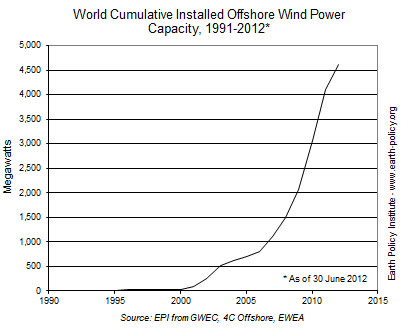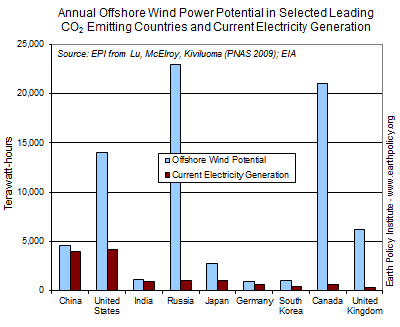By J. Matthew Roney
Wind power is the world’s leading source of renewable electricity, excluding hydropower, with 238,000 megawatts of capacity installed at the start of 2012. Thus far, almost all of this wind power has been tapped on land; worldwide just 4,600 megawatts of offshore wind farms were operating as of mid-2012. Offshore wind capacity is growing quickly, however, expanding nearly six-fold since 2006. Twelve countries now have wind turbines spinning offshore, and more will be joining them to take advantage of the powerful winds blowing over the oceans.
More than 90 percent of offshore wind installations are in Europe. Denmark erected the world’s first offshore wind farm in 1991—the 5-megawatt Vindeby project. Offshore wind grew sporadically through the 1990s, as Sweden and the Netherlands also added capacity. Denmark added 400 megawatts of offshore capacity from 2001 to 2003. Since then, however, despite several other countries joining in, the United Kingdom has totally dominated the market. Of the 520 megawatts of new offshore wind capacity installed in Europe in the first half of 2012, roughly 80 percent was in the Irish Sea and North Sea waters of the United Kingdom. The rest was built by Belgium, Germany, and Denmark. (See data.)
By the end of June 2012, the United Kingdom had 2,500 megawatts of offshore wind, over half of the world total. And the country hosts the world’s largest operational offshore wind farm, the Greater Gabbard project in the North Sea. All but 11 of its 504 megawatts were installed and connected to the grid by mid-2012. The United Kingdom also has the largest offshore wind farm under construction: close to one third of the London Array’s 630-megawatt first phase was installed by early May 2012. If approved, Phase Two would bring the project total to 1,000 megawatts.
Outside Europe, only China and Japan have operational offshore wind farms. Although its first offshore project was not installed until 2010, China already ranks fourth behind the United Kingdom, Denmark, and Belgium, with 260 megawatts. The government’s goal is 30,000 megawatts of offshore capacity by 2020. This could generate the equivalent of roughly one fifth of China’s current residential electricity consumption.
Japan, with just 25 megawatts of offshore wind power capacity, is developing a pilot 16-megawatt floating wind farm project off the coast of Fukushima. Elsewhere in East Asia, South Korea also has big plans for offshore wind, targeting 2,500 megawatts by 2019.
Where’s the US in Terms of Offshore Wind?
While the United States trails only China in land-based wind generating capacity, it has yet to install a single offshore turbine. For more than a decade, the developers of Cape Wind—a proposed 470-megawatt project off the coast of Massachusetts—have been obtaining permits and fending off legal challenges from groups opposed to the project. In August 2012, the Federal Aviation Administration (FAA) again determined that Cape Wind posed no threat to aircraft. (The FAA affirmed multiple times during both the Bush and Obama administrations that the project would be safe, only to have its determinations appealed by project opponents.) Developers aim to begin construction in 2013.*
Two other proposed projects off the U.S. East Coast slated to begin construction in 2013 are also vying to become the country’s first offshore wind farm. In July 2012, offshore developer Fishermen’s Energy received the final permit needed to begin construction of a 25-megawatt wind farm off Atlantic City, New Jersey. And in Rhode Island’s waters, the firm Deepwater Wind’s 30-megawatt wind farm would meet much of nearby Block Island’s electricity needs. Deepwater Wind has also proposed three 1,000-megawatt offshore wind complexes that would serve the New England and Mid-Atlantic regions, but these are still in the early planning stages.
Part of what has thus far stymied offshore wind in the United States is concern about the aesthetic impact of turbines visible from shore. With its Smart from the Start leasing program, the federal government’s Bureau of Ocean Energy Management hopes to avoid that controversy: the 2,400 square miles set to be auctioned off for wind development later in 2012 are located at least 10 miles from shore, on the Outer Continental Shelf off the East Coast. Smart from the Start also looks to proactively address other common concerns about wind power through careful siting to minimize effects on migratory birds, marine species, and archaeological sites.
One project that would facilitate wind development far from shore is the Atlantic Wind Connection, a proposed offshore “transmission backbone” of highly efficient underwater high voltage direct current cables financed by Google, Marubeni, and other investors. Stretching some 300 miles from New York to Virginia, this venture could connect some 7,000 megawatts of offshore wind to the Mid-Atlantic’s population centers. In mid-2012 the project entered the environmental review stage of obtaining a federal right-of-way. Complete construction would take approximately 10 years.
In contrast to the Pacific Coast’s steep drop-off, the U.S. East Coast enjoys a wide, shallow expanse of continental shelf that is especially favorable for offshore wind development. The National Renewable Energy Laboratory estimates that wind turbines installed in the shallow waters of the Mid-Atlantic region could add up to nearly 300,000 megawatts of capacity—enough to power 90 million U.S. homes. For the entire Atlantic Coast, including deeper waters, the resource is estimated at 1 million megawatts.
Nine of the top 10 carbon dioxide emitting countries in 2010 have more than enough offshore wind energy potential to meet all their current electricity needs. (The one that does not is Iran.) Russia’s offshore wind resources, for example, exceed its current electricity demand by a factor of 23. Canada’s current electricity needs could be met 36 times over with domestic offshore wind energy.
In addition to the twelve countries with operational offshore wind farms, some 20 others, including Australia, Brazil, and India, have offshore projects in at least the planning stage. In the near term, however, the current leaders in offshore wind are expected to remain the principal sites for deployment. The International Energy Agency projects that even with tight supplies of undersea transmission cables and construction vessels causing some delays in development, offshore wind power will grow nearly six-fold to 26,000 megawatts by 2017. China, the United Kingdom, and Germany are expected to account for more than 70 percent of the new installations. As interest grows and technology advances, offshore wind appears headed for a prominent position in the world’s renewable energy mix.
*This article has been updated to reflect news of the latest FAA determination, announced shortly after the original text was finalized.
Data and additional resources at www.earth-policy.org.


